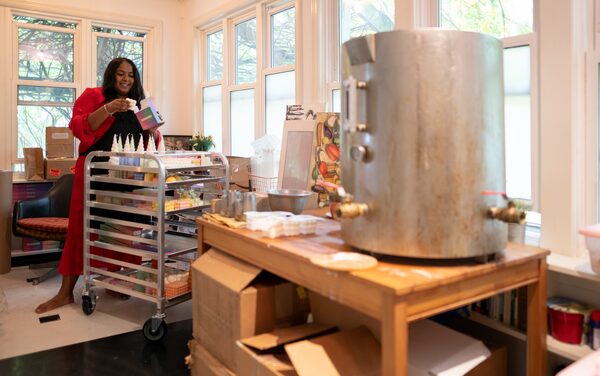
Monika Mann loves candles and fresh flowers. While at home during the pandemic she began making candles and her products were an instant hit on social media. She now works on her creations full-time from her home in Toronto.Peter Power/The Globe and Mail
Monika Mann was already an Instagram user in November when she started making candles, so she posted pictures of them on the social network as a matter of course.
“Literally overnight, I had 178 messages from people I don’t know about these candles,” says Ms. Mann, who lives in Toronto. “I had absolutely no idea what I was doing but was like, ‘I am going to roll with it. It will be great.’”
At that time, she had a day job in sales for a clothing manufacturer, so she spent evenings and weekends making candles to keep up with the demand coming in through Instagram. Then in February, after she nailed down her branding and launched a separate Instagram account for the company, business exploded again: She started hearing from retailers and wholesalers interested in her products.
“I decided to quit my job … It was a wild thought,” says Ms. Mann, whose Mmann Candles now makes about 50 pieces per day. “It happened very quickly … If it wasn’t for Instagram, I wouldn’t have been able to start my business.”
Social commerce, or selling products directly through social media, is expanding rapidly. Many social media platforms now have features to help facilitate sales, such as Pinterest’s product pins or Instagram’s product tags, which take users from a post containing a product to a place to purchase it in a click.
Buyers are spending increasing amounts of time online and are seeking closer relationships with the brands they patronize, helping businesses tap into new markets.
At Pinterest, which bills itself as a “visual discovery engine for finding ideas like recipes (and) home and style inspiration,” businesses who uploaded their product catalogues to the platform increased 14-fold globally between March 2020 and March of this year, according to figures provided by Pinterest spokesperson Ashley Mossman.

Buyers are spending increasing amounts of time online and are seeking closer relationships with the brands they patronize, helping businesses tap into new markets.Peter Power/The Globe and Mail
In June, Pinterest expanded its shopping functionality in Canada, allowing users to shop from more of the platform’s features such as its search and boards.
“Our vision for shopping is to make it possible to buy anything you see on Pinterest, or get personalized recommendations for something just like it,” the company said in a statement to the Globe.
Meanwhile, a report released last year by market research firm Research and Markets tallied global social commerce sales at US$89.4-billion, with expectations they’ll grow to US$604.5-billion by 2027. The researchers singled out Canada for a “noteworthy” growth forecast of 27 per cent over that period.
Doug Stephens, a retail consultant based in Hamilton, Ont., agrees that social commerce has lots of room to grow in North America, and sees live-streaming as an obvious area for expansion.
Mr. Stephens, founder of Retail Prophet Inc., says live-streamed product demonstrations are already a well-established sales channel in Asia, where Chinese influencer Viya gets a bigger audience than Sunday Night Football when she goes live online to sell products.
“She sold $72-million of products in one day,” he said. “It’s like the Shopping Channel but being hosted on Instagram or TikTok.”
Mr. Stephens says the pandemic and the rising popularity of online influencers have both contributed to the success of social commerce, but he believes the phenomenon is part of something bigger: a role-swap between a brand’s stores and their media channels.
“Traditionally … retailers would go out on the market and buy media in an effort to convey info about their brands … with an eye to driving consumers to a point of distribution,” he says.
“Around 2013, we started to detect a shift whereby, increasingly, media was becoming the store, at least in the consumer’s mind,” he says. “If I saw an ad on Facebook, that was, in the consumer’s mind, a direct path to making the purchase. It was no longer a callout; it was the store.”
On the other hand, Mr. Stephens says, storefronts are becoming more of a venue for customer acquisition: a place for consumers to see or test out the product, even though they may eventually purchase it online.
Victor Tam, co-founder and chief executive officer of Vancouver luggage company Monos, strongly recommends social commerce for a company that is just getting started, saying the return on investment can be high if a company focuses on creating a recognizable esthetic and consistent content.
Monos launched in 2019 and almost folded when the pandemic struck the following year. But the company doubled down on marketing luggage online at a time when competitors were holding back and saw significant growth despite the lockdowns and travel restrictions.
“If you can keep creating unique, original content … that’s where you excel,” he says, adding that testing different types of content by measuring its click-through rates is a good way to stay on the right track.
“Our ethos is really not trying to put our product front-and-centre in the image. We’re not saying, ‘This is a luggage company with luggage and here are the features,’” he says “A lot of our imagery (features) people and landscapes and locations. The luggage and backpack seamlessly blend in.”
Mr. Stephens believes any type of company can succeed at social commerce, provided they follow the following three guidelines:
- “Don’t sell, just tell.” He says demonstrating a product adds value for customers wondering how the product works. “We can’t just be there with ads.”
- “Be fully transparent.” Anyone being paid to market a product online should be honest with their audience if they want to maintain credibility.
- Make quality content: Share valuable information in an interesting way, with high production values and solid branding.